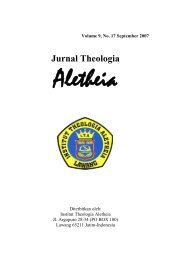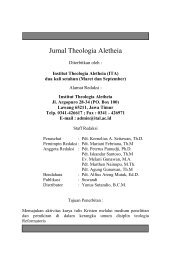download - Sekolah Tinggi Theologia Aletheia Lawang
download - Sekolah Tinggi Theologia Aletheia Lawang
download - Sekolah Tinggi Theologia Aletheia Lawang
Create successful ePaper yourself
Turn your PDF publications into a flip-book with our unique Google optimized e-Paper software.
105<br />
In the narrative setting of Luke, the parable may be construed<br />
as continuing the theme enunciated in 10.21: what the wise and the<br />
learned failed to see, the ‗children‘ saw, i.e., the significance of<br />
Jesus‘ ministry as that which truly reveals the Father. The parable<br />
of the Good Samaritan fits hand in glove with this thrust in that<br />
those who saw and practised the real meaning of the creed of Israel<br />
might not be the wise and learned (cf. the priest and the Levite) but<br />
children (cf. the Samaritan). Thus the theme of the ‗unexpected<br />
members of the covenant‘ runs through both of them. Indeed, the<br />
pericope which follows, i.e., the story of Martha and Mary,<br />
continues such a thrust. Mary chose to sit at the feet of Jesus and<br />
by so doing has chosen the better thing. This runs counter to Jewish<br />
customs which dictate that the better place for a woman to be in is<br />
the kitchen. 157<br />
Conclusions<br />
The parable does not offer us an allegory of the fall of man<br />
nor does it give us a moral story on how we are to be good<br />
neighbours, as important as this may be for Christian ethics. Nor<br />
was it told to establish a halakhic point. Instead, there is actually<br />
more that is at stake in the telling of the parable for the questions<br />
which prompted it have to do with the identity of the true people of<br />
Yahweh or those who would inherit the life of the age to come.<br />
To summarise the main points of our proposal: the parable<br />
gives the identity of the people who would inherit the life of the<br />
age to come. These are the people who confess the Shema‗ and<br />
show it by practising its primary praxis: that of love for Yahweh<br />
and love for the neighbour. What this means has now been<br />
redefined by Jesus. In this redefinition, the neighbour is not<br />
in the Jesus traditions, the recent work of S. Bryan, Jesus and Israel‘s Traditions<br />
of Judgment and Restoration, Cambridge: Cambridge University Press, 2002.<br />
157 Many commentators find it hard to string these pericopes together and this is<br />
not surprising as Luke does not offer us clear hints.




